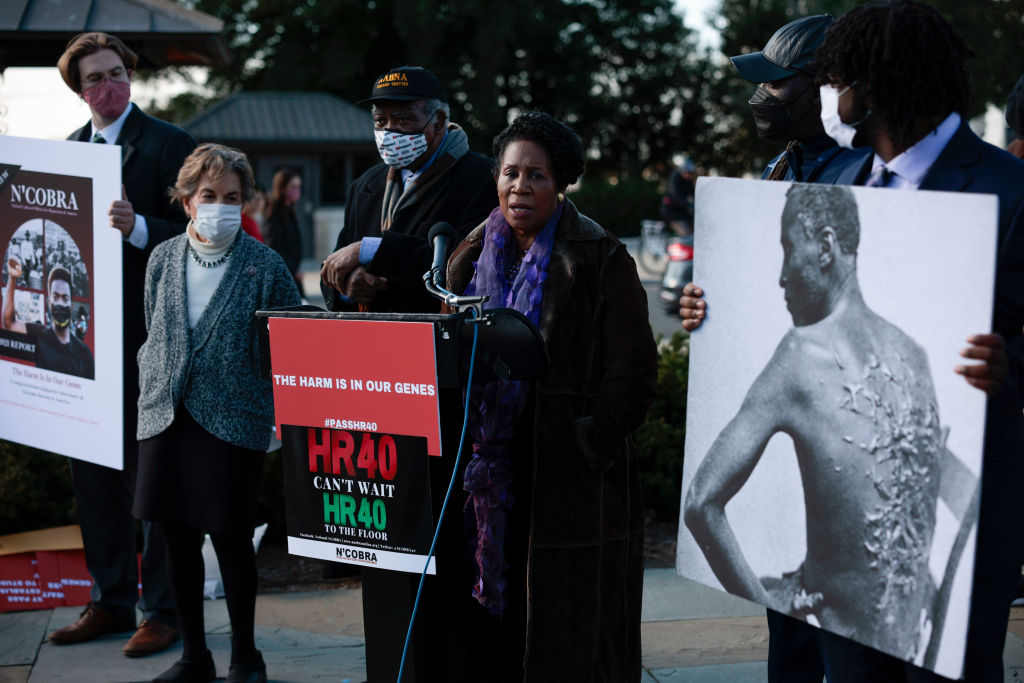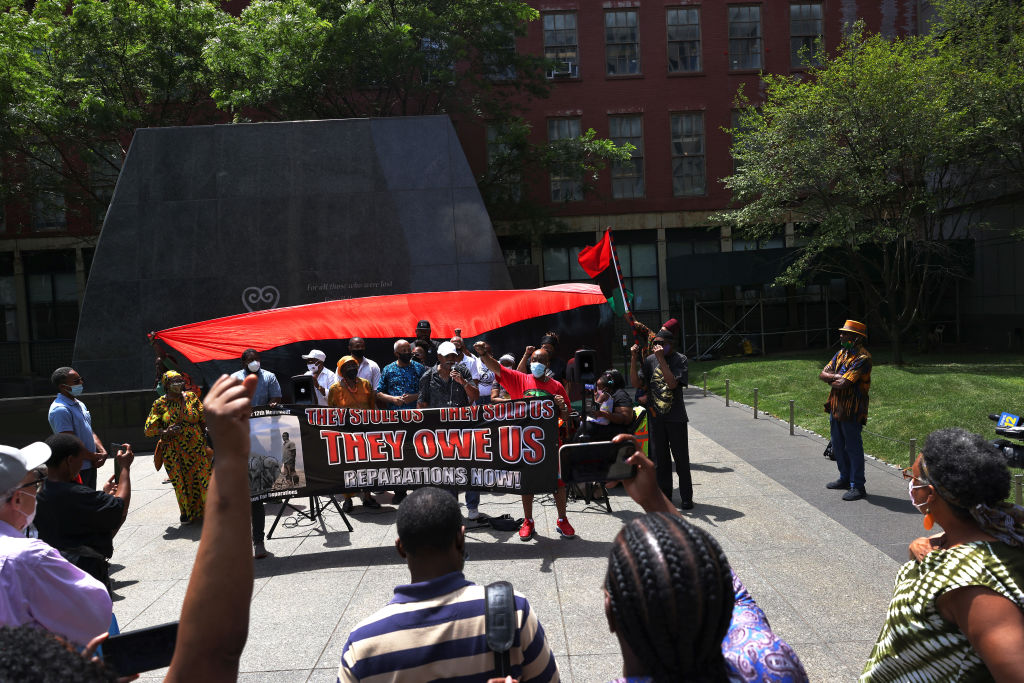“This is a huge moment for Black Americans and their history in this country,” said Dr. Ron Daniels, convener of the National African-American Reparations Commission.
If “walk it like I talk it” was a person, it would be Robin Rue Simmons.
The former alderman in Evanston, Illinois, made history in 2019 when she successfully instituted a reparations program specifically geared toward her city’s Black constituents who are linked to earlier generations of racist discrimination. Simmons’ efforts have unequivocally helped bolster interest in pending legislation for a national reparations program.
“What we’ve done in Evanston is successful because we have inspired our community to think differently about how we restore the harm done in our Black community,” Simmons told NewsOne during a recent phone conversation.
But even with the pomp and circumstance of cultural observances like Black History Month, the Martin Luther King federal holiday and things like honorary street namings helping to raise awareness of the movement for reparations, Simmons cautioned that any rejoicing from her program was premature.
“We have still not done the work to repair past harm that was intentionally anti-Black,” Simmons said.
Reparations in action
The movement for reparations for slavery is enjoying the most momentum its seen in the 33 years since the House Resolution 40 (H.R. 40) legislation to study and develop proposals for African Americans was first introduced by Michigan Congressman John Conyers. With historical precedent around the world and a growing number of municipal reparations efforts in the U.S. not unlike Simmons’, there is no shortage of models to draw upon while imagining the myriad possibilities of what reparations can look like. “It’s not just cash,” Simmons said, a sentiment that’s left experts and scholars alike optimistic about what they call reparative justice to adequately address a widening racial wealth gap and help lift white supremacy’s knee off Black America’s neck, slowly but surely.
Simmons – who has since left public office to become the executive director of FirstRepair, a nonprofit she founded that works to educate people about local and national reparations efforts – described getting H.R. 40 enacted as a “goal” of hers.
That is especially true considering Simmons’ success in Evanston. The city – the first in the U.S. to establish a reparations program – allocated $400,000 through the Local Reparations Restorative Housing Program for housing and mortgage relief. Eligible residents may receive up to $25,000 to qualifying residents for home repairs, mortgage help, or down payments on property. The Restorative Housing Program is eligible to residents or direct descendants of Black residents who lived in the city between 1919 and 1969. Those who moved into the city after 1969 may still be eligible. Residents would need to provide evidence of discriminatory housing practices enacted by the city.
“If you are a descendant, you have been harmed,” Simmons said.
Either way, Simmons said, achieving any semblance of restorative and reparative justice won’t be overnight.
“It will take time,” Simmons said.
How long, exactly, has yet to be determined.
However, Dr. William Darity Jr., a professor of public policy and economics at Duke University who literally helped write the book on reparations, said he was hopeful the country is moving in the right direction.
Darity, who co-authored “From Here to Equality: Reparations For Black Americans In The 21st Century” alongside A. Kirsten Mullen, recently explained to NewsOne the various forms that reparations could look like. He cited successful examples like Germany compensating victims of the Holocaust and the U.S. government paying Japanese American victims of unjust mass incarceration during World War II, the latter on which Conyers modeled the first iteration of H.R. 40, which has since been reintroduced by Texas Congresswoman Sheila Jackson Lee.
Rep. Sheila Jackson Lee (D-TX) speaks at a press conference on H.R. 40 legislation on Capitol Hill on November 16, 2021, in Washington, D.C. | Source: Anna Moneymaker / Getty
Darity said payments didn’t have to be cash only.
“But the monetary payments are essential,” Darity said, because the end goal is the “elimination of the racial wealth gap in its entirety.”
Darity also said there is an educational component of his book’s vision for reparations in order “to correct the false, Lost Cause narrative about slavery, the Civil War, and Reconstruction that the United Daughters of the Confederacy and the Daughters of the American Revolution have embedded in our national consciousness.”
Who should get reparations?
When it comes down to who is eligible to receive reparations for slavery, the answers have sometimes been a source of contention.
Darity said he and Mullen came up with two ways that will qualify people for reparations: “1. an individual will need to show they have at least one ancestor who was enslaved in the United States and 2. An individual will need to show that they self-identified as Black, negro, African American or Afro-American for at least 12 years before the enactment of a reparations plan or a study commission for reparations.”
Another way to put that, Darity said, is that “Black American descendants of U.S. slavery should be the eligible recipients.”
Darity placed a price tag of “at least $14 trillion” to begin to close the racial wealth gap, which he said is now averaging about $350,000 per person and “is the best single economic indicator of the cumulative, intergenerational effects of white supremacy.”
The American Descendants of Slavery (ADOS) movement has taken umbrage with certain eligibility aspects and wants to restrict qualifications for reparations to only Black descendants of slaves, as opposed to all Black people, such as immigrants.
Darity noted that while there are some “toxic actors” advocating for ADOS, “particularly on social media,” he suggested the group has more positives than negatives.
“Overall the [ADOS] movement has been instrumental in keeping the conversation about reparations on the public stage and in making clear who should receive reparations for African Americans,” Darity said.
Dr. Ron Daniels, convener of the National African-American Reparations Commission (NAARC), said ADOS’ preferred eligibility for reparations “runs counter to the mainstream view of the inclusiveness of the African American community.” He said that while some folks have broadly bought into that line of thinking, “We are not about to try to trace whether Malcolm X’s lineage is eligible for reparations because they came from the Caribbean. That is a nativist kind of formulation that is broadly being rejected.”
A message sent to the ADOS Advocacy Foundation for comment was not immediately returned.
People listen to speakers during a rally for reparations at the African Burial Ground National Monument on July 23, 2021, in New York City. | Source: Michael M. Santiago / Getty
Daniels pointed to NAARC’s 10-point reparations plan as being a framework for how to educate people around H.R. 40, which can advance either through legislation or presidential executive order.
“We strenuously and vigorously support local reparations, Daniels said of NAARC. “But at the end of the day it’ll be federal legislation that makes the biggest difference,” he added, noting that, “it was the federal government that was complicit and played a leading role in the enslavement of people of African descent and continued over generations.”
That makes the U.S. complicit in that harm, he said.
High hopes for reparations legislation
“That bill [H.R. 40] now stands on the verge of being enacted,” Daniels said optimistically.
He said his hopes were high because of a growing number of co-sponsors in Congress for H.R. 40 and others who have pledged to vote in favor of the legislation. He said since there is so much Congressional support for H.R. 40, “we now need to talk about remedies.”
Daniels also seemed confident about when – not if – reparations would advance on Capitol Hill because of its legal aspect.
“The idea of reparations is not some crazy, cockamamie idea,” Daniels said. “It is embedded in international law. Groups of people who are injured by another group are due repair – an acknowledgement, an apology and then redress compensation restitution – that is international law.”
He added: “The idea of reparations is not outside the mainstream scope of international law. The problem is getting an offending nation to acknowledge it.”
Mentioning the unfulfilled “40 acres and a mule” promise from the U.S. to former slaves in 1865, Daniels drew attention to how slaveowners were instead the ones who were compensated by the federal government when slavery was abolished.
He said that now, what was most important was being able to define what the remedy from reparations will be.
“Not one suit fits all or one model, but there are broad principles, Daniels said. “The most important thing is the party that inflicts the harm cannot define the remedy.”
That means, he said, it will not be up to the U.S. to define what reparations is or can be. Instead, it will be the commission that makes the proposals.
When asked, Daniels — who worked as deputy campaign manager for Rev. Jesse Jackson’s presidential bid in 1988 — admitted that he never thought he’d even see this moment in his lifetime, let alone being a major catalyst in the movement for reparations.
“I am amazed, as a veteran and organizer, I would never believe I’d be saying this – we are on the verge of an acting commission that will actually not be debating or pontificating but will be studying specific reparations proposals,” Daniels said. “This is a huge moment for Black Americans and their history in this country.”




